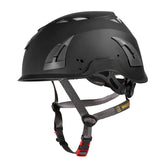At Leach’s, it’s our aim to help completely eradicate injuries or deaths on-site as a result of working at height.
Yes, we know it’s a bold aim. The bar is set high.
But if no stone is left un-turned in the desire to improve personnel and site safety, we truly believe we will be in a good position to ensure all tradespersons can carry out their work at height safely.
To move us forward on that journey and ensure important safety considerations are kept front of mind when working at height, we’ve developed a useful and memorable planning framework. It’s called STRICTPLAAN.
Introducing STRICTPLAAN
The only way to ensure safety when working at height is by deploying and following a strict assessment and planning process. That’s where STRICTPLAAN can help.
STRICTPLAAN is designed to cover critical safety considerations when working at height. It entails:
S – Scenario – Evaluate the scenario
TR – Threats and risks – Understand the threats and risks
I – Instigate – Instigate proper planning
C – Competencies – Evaluate worker competencies
T – Training – Ensure thorough training
P – PPE – Choose quality PPE & height safety tools
L – Look – Look at your equipment before each use
A – Actionable – Create an actionable emergency and evacuation plan
A – Assure – Assure regulatory compliance
N – Never – Never get complacent
DOWNLOAD: STRICTPLAAN – Leach’s Guide to Working Safely at Height
S – Evaluate the scenario
One of the most important steps to take before undertaking any work at height is asking the question… “Do I need to?"
That is because the simplest and most effective way to avoid falls and injuries at height is not working at height. So, before you start climbing that ladder, closely evaluate the scenario to determine if it is absolutely necessary. In the first instance, and if possible, we always recommend undertaking as much work as possible with two feet on the ground.
TR – Understand the threats and risks
Now you’ve concluded the job requires working at height.
Before undertaking any work, a competent person should identify all the health and safety threats and risks workers could face. This can be achieved by conducting a full and thorough risk-assessment.
We advise employers to create and deploy a formal procedure, ensuring a risk-assessment is clearly defined, documented and all the relevant safety procedures are adhered to by those working at height. If you will be undertaking the work, be sure to check that a risk-assessment has been completed and you fully understand the protocols that have been put in place to keep you safe.
I – Instigate thorough planning
Now you’re aware of the risks, it’s time to put a strict plan in place.
Any work at height must comply with the Work at Height Regulations 2005. It is the duty of the employer, self-employed, or any person who controls the site or work of others, to create clearly-defined safety measures that prevent the risk of personal injury.
This is often referred to as a method statement. It must include:
- Scope of the project
- Means of access, such as scaffolding or lifting cage
- Lighting details
- Plant and equipment required
- Materials or substances used that could be hazardous or flammable
- Pre-determined risks and their controls
- Training provided
- Supervision required
- Site maintenance and storage
- PPE required and instructions for use
- Power requirements
- Working at height requirements
- Third party protection
- Emergency and rescue provisions
- How this plan will be communicated to the workforce
C – Evaluate worker competencies
Everyone working at height must have the relevant skills, knowledge, ability and experience to do so; this is called worker competency. Asking a tradesperson without the right skills to work at height safely is an accident waiting to happen.
Experience and competency is critical. It helps those in dangerous environments recognise the risks before an accident occurs, so they can use their knowledge to mitigate that threat.
We discuss how to decide if someone is competent to work at height in the full STRICTPLAAN guide but, whatever the scenario, we recommend thorough training for every member of staff that is involved in the working at height process.
T – Ensure proper training
Effective training doesn’t just protect those working at height, but also the people around them. A dropped tool could cause some serious damage to a worker or pedestrian below if the right measures aren’t in place. Proper training will help protect the entire team.
Although not everyone on a construction site is asked to work at height, we recommend giving as many workers the opportunity to train as possible. If it’s likely they’ll be asked to help with a job, even when it isn’t their core expertise, they need to be confident to deliver. It is best-practice to ensure every staff member who may be called upon for support is properly trained.
P – Choose quality PPE and height safety tools
There’s nothing more important to your health and safety when working at height than utilising the right equipment and protection. But protection itself isn’t always enough...
Is your Personal Protective Equipment (PPE) best-in-class? Does it comply with the latest regulations?
It’s easy to get caught out by equipment when the price tempts, but there are two risks attached to this procurement approach:
- It may break or fail, and you could find yourself making many repeat purchases which will cost you more in the long run.
- If it does break or fail, buying more equipment might be the least of your concerns. What if a member of your team was injured in the process?
L – Look at your equipment before each use
Now you’re one step ahead and you have the best PPE and safety equipment available on the market, but when was the last time you had a really good look at it?
It’s good practice for all PPE and height safety equipment that you conduct visual inspections before each use. That helmet you’ve been wearing may’ve been the best available at the time, but is it still in good shape now? Check before you put it on again.
The BS EN 365: 2004 Personal protective equipment against falls from height standard instructs users of fall arrest equipment to re-certify equipment on a 12-monthly basis. Some textile webbing products may need to be tested every 6-months at least, or every 3-months if being used in arduous conditions.
A – Have an actionable emergency evacuation and rescue plan
While you should make every effort to reduce all risks when working at height, unfortunately accidents can still occur. You must have an easy-to-action, well-drilled emergency evacuation and rescue plan ready.
A plan should include an agreed and firmly set procedure for evacuations and rescues. Make sure you and your team know exactly what could wrong and practice what to do in those situations. You can’t just rely on the emergency services to conduct an evacuation or rescue.
STRICTPLAAN: Leach’s Best Practice Guide to Working Safely at Height
A – Assure regulatory compliance
Good awareness of all the relevant legislation and regulations that exist to mitigate against any risks is essential.
If you or your employees are working at height, you will need to comply with the Work at Height Regulations 2005 (WAHR). These regulations apply to an employer or if you control work at height (contractor or factory owner).
Any work at height must be properly planned, supervised and carried out by competent people with measures in place to protect everyone at risk. Non-compliance with the relevant legislations could result in:
- You and your team being at risk of injury due to poor safety practices
- Potential fines and site closures
N – Never get complacent
Train, train and then train again. Never get complacent. It isn’t a one-time thing. Training gives confidence, increases knowledge, and upskills tradespersons so they can carry out their work effectively with minimal risk. Training is one of the most important tools to prevent injuries on-site. A worker must be confident using the tools at their disposal.Need some more support?
We’ve put together the STRICTPLAAN work at height planning framework to cover the main points of height safety and encourage best practice. Of course, this isn’t an exhaustive guide and we always recommend speaking to a height safety specialist to support your requirements.
If you need any equipment advice, or if you have any further questions, please contact our dedicated sales team on sales@www.leachs.com or 01432 246 800.


















